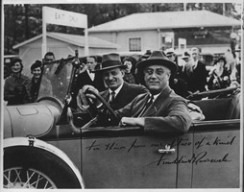Archive
The Unlikely Team of Farm Credit Architects
By Jim Putnam
It was highly improbable that the life paths of Franklin D. Roosevelt, Henry Morgenthau, Jr. and William I. Myers would have converged in 1933 to complete the building of the cooperative Farm Credit System that was begun by the original “founding fathers” nearly 20 years earlier. Of course much of history consists of highly unlikely events that changed the course of human affairs. And, this is definitely true of our Farm Credit history.
Roosevelt, Morgenthau and Myers were all from New York State. That’s about all they had in common.
Roosevelt was from an “old money” blueblood family. Morgenthau was the second generation of a German-Jewish family. Myers was from a “middling sorts” rural heritage in the Hudson Valley and Pennsylvania. Roosevelt and Morgenthau had started life in New York City, while Myers was born in the rural hamlet of Lowman in New York’s Southern Tier.
Roosevelt was a lawyer by training, but had spent most of his adult life in politics. Morgenthau had tried his hand at a variety of things including farming, managing his father’s business affairs, publishing a farm magazine and then becoming one of Roosevelt’s most trusted advisors for nearly two decades. Myers had studied agricultural economics, eventually earning a Ph.D. at Cornell University and becoming a professor of farm finance on its faculty. Roosevelt and Morgenthau were from the city, while Myers was decidedly upstate in a state where these regional differences are profound. Roosevelt and Morgenthau were, of course, Democrats. Myers was a Republican.
Roosevelt and Morgenthau met in 1913 and became good friends. They were neighbors in Dutchess County – Roosevelt at Hyde Park and Morgenthau at Fishkill. Both shared an interest in farming and Democratic Party politics. While both Myers and Morgenthau were students at Cornell as young men, there is no record of their becoming acquainted then. After Roosevelt was elected Governor of New York State in 1928, however, the three men began to directly collaborate.
Roosevelt and Morgenthau were quick to reach out for advice from Professor George F. Warren, the head of the ag economics department at Cornell, Myers and others in their department. Through Morgenthau’s ownership and being publisher of the American Agriculturist after 1922, however, it is likely that he would have at least become familiar with Myers’ work, if not having met him some time before 1928.
Roosevelt was elected President on November 8, 1932. America was besieged:
- Since 1929 the Great Depression had deepened, despite the Hoover Administration’s turnaround efforts.
- The banking system was in shambles, with hundreds of banks already having failed.
- The farm sector had been depressed since 1920, defying all efforts to revive it.
Even before Roosevelt won election, Myers was working on a plan. It would not only deal with the current problems in farm finance, but it would build a permanent Farm Credit System to provide all of the credit needs of farmers and their cooperatives. The System would be built on cooperative principles with full ownership by farmers as a future goal. It would lend money based on both safety and soundness. It was intended to enable America’s successful farmers to own their own lending System so that they would not need to rely on direct lending by the government.
Myers presented his plan to Morgenthau in December 1932, who in turn shared it with Roosevelt. It was a go and became a key element of Roosevelt’s agenda for rescuing American agriculture. While some of the details would be refined in the coming months, Myers’ basic framework was readily embraced by the President-Elect and was put into law.
From today’s perspective in which the wheels of our Federal government turn very slowly, it is amazing what was accomplished in a relatively short time – and how incredibly well it has stood the test of time.
March 4, 1933 – Roosevelt is inaugurated. Shortly thereafter, Morgenthau is appointed to head the Federal Farm Board. Myers is an advisor to Morgenthau at this point, on leave from his professorship at Cornell.
March 27, 1933 – Roosevelt issues an executive order reorganizing all farm lending programs into a new agency named the Farm Credit Administration. Congress has 61 days to overturn this Order before it becomes operational
May 12, 1933 – The Emergency Farm Mortgage Act is passed by Congress and signed into law by Roosevelt. The Federal Land Banks are given the daunting assignment of leading the rescue effort for farm mortgage lending – more on that in a future post.
May 27, 1933 – The Farm Credit Administration, with no objection from Congress, comes into operation with Morgenthau as its first Governor and Myers as Deputy Governor.
June 16, 1933 – The Farm Credit Act of 1933 is passed. This was detailed in our last post.
November 17, 1933 – Morgenthau is appointed Deputy Secretary of the Treasury. Myers is appointed as FCA’s second Governor.
January 1, 1934 – Morgenthau is appointed Secretary of the Treasury.
Next: Henry Morgenthau, Jr. – Part I
Photo: Franklin D. Roosevelt and Henry Morgenthau, Jr., 1934.
– See more at: http://www.farmcreditnetwork.com/newsroom/blog/article/the-unlikely-team-of-farm-credit-architects#sthash.fHf7m4hO.dpuf
